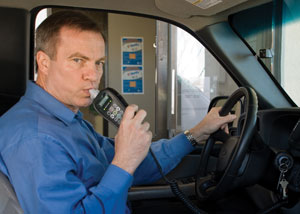By Mitch Becker
New electronic devices have changed the way we talk about, drive, maintain and repair vehicles. Society today is looking to these electronic devices – such as vehicle ignition interlock devices (IIDs) – to change some of the social aspects of people’s lives, too.

With an increasing number of vehicles being equipped with these devices, it’s best to have a plan in place if one arrives at your shop. One ABRA Auto Body & Glass shop saw four such vehicles in one week, so they’re out there!
Sad Statistics
What is an IID? It’s a device that serves as a practical, reasonably priced way to monitor and prevent repeat drunk driving offenders from getting behind the wheel while under the influence. All 50 states have various programs that use these devices for people convicted of impaired driving.
Last year, drunk drivers killed 11,773 people on U.S. roadways. In 2009, 1.4 million drivers were arrested for driving while impaired, with alcohol cited as the main source of impairment. The National Highway Traffic Administration (NHTSA) estimates that only 1 percent of all drunk drivers are arrested on U.S. highways and roadways each year – and many are repeat offenders.
Keeping people from getting behind the wheel while under the influence has been a big obstacle for years. Legislators have been looking for ways to reduce or prevent repeat offenders. Monitoring offenders has been the hardest and costliest hurdle for most states.
Optional or Required?
First-time offenders who are stopped and have a high level of blood alcohol concentration (BAC) can volunteer to have an interlock device installed or be required to have one installed. In states where it’s optional, many drivers volunteer to participate in order to get their license privileges reinstated more quickly. In states where it’s a requirement, offenders are under contract or court order not to drive any motor vehicle not equipped with an interlock device. The cost of the device and monthly subscription for monitoring is usually the responsibility of the vehicle owner.
One interlock company boasts over 5 million prevented starts of vehicles equipped with their devices. Some 2010 Volvo models offer factory-installed interlock devices called Alcoguard. Other carmakers are working with NHTSA and similar government agencies to provide factory-installed IIDs as an option on future vehicle models.
How They Work
Let’s take a look at how IIDs work. The state DMV contracts and/or certifies companies to install and monitor the devices in vehicles. Many different companies manufacture many different versions of IIDs.
The ignition interlock is primarily a breathalyzer – a handheld device that’s installed into a vehicle’s ignition wires. Before the car can be started, the driver must blow into a tube so a computer can check for any BAC. If alcohol is detected, the vehicle won’t start.
Many interlock devices will lock down the ignition for 30 minutes before allowing another test. While the vehicle is in motion, the system will call for random testing, which can be safely done by blowing correctly into the tube. Since it would be dangerous to shut down a moving vehicle if alcohol is detected, some IIDs will cause the horn to go off and lights to flash until the vehicle is turned off.
All failed tests are registered in the interlock computer, which is read on a monthly basis by the monitoring site. Failed tests are registered for time and date, and the information is then forwarded to the DMV.
The procedure for blowing into the tube for a breathalyzer test may be different for each device manufacturer. The test is designed to be interactive so as to prevent circumvention by using mechanical devices or other methods. Some interlock devices use fingerprint ID or take a photo during the test.
Have a Plan
What should a collision repair facility do when it encounters a vehicle with an IID? There are some serious issues to address:
• Should technicians be blowing into these devices?
• What if the technician or service writer blows a positive?
• Do you want everyone in the shop sharing the same blow tube as the vehicle moves through the shop?
The first thing you should do is have a private discussion with the owner to determine exactly how the device is used. If you choose to use the device to start vehicle, have the owner demonstrate the proper operation.
Blowing into a breathalyzer used by someone else or multiple drivers is obviously not sanitary. The owner may have extra breathing tubes to switch out on the handset.
Some devices require a driver to blow, inhale breath back in, then blow out again to prevent fraudulent or false blows. If the device is used incorrectly and a no-start is triggered, the car won’t start until the test is done correctly.
The worse case scenario would be if one of your techs ends up blowing a positive for alcohol. Remember, the owner is responsible for all tests. A police report may be required to clear the owner of a violation. The responding officer may require your tech to take a breathalyzer test. Now, the shop faces both legal and human resources issues.
Another thing to consider is although interlock devices are generally reliable, they may register false positives for certain foods or other factors.
Notification
At this time, interlock companies say the best practice is to have the vehicle owner notify the state DMV or organization that issued the court order or contract that vehicle repairs are needed.
If the vehicle isn’t in the state where the contract was issued, the issuing state would have to be contacted for guidelines. The state may need to notify the interlock company or the certified interlock installation center. Some interlock installers have mobile units to dispatch to repair shops to disconnect the system.
When the repair is complete, the unit would need to be reinstalled before the owner picks up the vehicle. Since there will probably be fees involved, the shop must get the vehicle owner’s authorization prior to scheduling the repair. Or, the vehicle may have to be taken to an authorized ignition interlock installation center for disabling.
To be directed to a certified center, call the number for the interlock provider found on the interlock unit. Fees may be involved for this service. So far, shops have been able to get insurers to pay for extra costs associated with IIDs. If they can’t, shops have found ways around using the device such as Go Jaks. If the vehicle doesn’t need to be started, the accessory option on the steering column will release the steering wheel and transmission so it can be towed or moved around on jacks.
Some devices have a code that can be entered into a hand unit keypad for a limited number of bypass starts. Using the code may require extra documentation from the shop.
Shops should also check the laws in their states for restrictions imposed on drivers. Rental cars and loaners may not be permissible while the vehicle is being repaired.
In the U.S., a list of federally approved IIDs is maintained by NHTSA’s Conforming Products List.
With all the rules and potential pitfalls surrounding the repair of vehicles with IIDs, it’s important to plan first and blow later.
Mitch Becker is a technical instructor for ABRA Auto Body & Glass. Reach him at (763) 585-6411 or [email protected].
Article courtesy of BodyShop Business.













